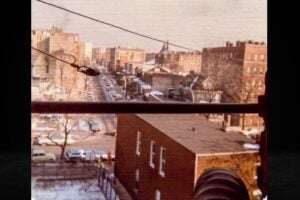
Fiorello La Guardia Photo Credit at end of article.
Whether you’re a New York native or have just visited the city on occasion, it’s hard to not know at least something about Fiorello La Guardia. He was the 99th mayor of New York City. Fiorello La Guardia also served two terms in Congress. His progressive ideals and his persistent nature are what many people remember him fondly for. The diminutive mayor (he stood five foot two inches tall, and was often known as the “Little Flower” which is what his first name translates to in Italian) made an indelible mark on city, state, national and international politics.
Fiorello La Guardia was born on December 11, 1882 in New York City. His father Achille was originally from Cerignola, Italy. Fiorello’s mother Irene was a native of Trieste, Italy. The family later moved to Arizona after Achille La Guardia accepted a position as bandmaster at the US Army post at Fort Whipple. Fiorello attended public elementary and high schools in Prescott, Arizona during that time. His father was let go from his bandmaster position in 1898, and the family lived in Trieste for a brief period. Fiorello graduated from high school at the Dwight School, an independent private preparatory school in New York City’s Upper West Side.
La Guardia joined the US State Department in 1901. He worked at consulate offices in Trieste, Budapest and Flume (which is now Rejika, Croatia).for the next five years. Fiorello returned to the United States in 1907 to further his education at New York University. He also served as an interpreter at Ellis Island for the U.S. Bureau of Immigration from 1907 to 1910. La Guardia was a certified interpreter for the Croatian, German, Italian and Yiddish languages.
Fiorello graduated from New York University’s School of Law in 1910 and was admitted to the bar later that year. He soon began his own law practice in New York City. La Guardia’s first taste of politics five years later, when he became New York’s Deputy Attorney General in 1915, He would be elected to the U.S. House of Representatives the following year.
La Guardia began his first term in Congress in March 1917. He represented New York’s 14th congressional district. Fiorello worked hard for immigrants. He had a good understanding of their challenges and struggles from his time spent as an interpreter at Ellis Island. La Guardia also supported internationalism. He wanted countries to work together to solve problems and strongly favored peace over war.
Unfortunately, La Guardia’s congressional term was interrupted as he was commissioned to the U.S. Army’s Air Service during World War !. Fiorello eventually became a major. He later commanded several Caproni Ca.5 bombers that were stationed on the Italian-Austrian front. After the war, La Guardia was re-elected for a second term in Congress. However, he decided to resign from his position at the end of 1919.
Fiorello was not finished with politics, however. He was appointed as the Republican candidate for president of the New York City Board in 1919. His primary opponents were incumbent Democrat Robert L. Moran and New York’s Third “Shamrock” Battalion leader Michael Kelly, who was also known as “Dynamite Mike” for his explosive personality. The efforts of political organization Tammamy Hall kept Kelly’s name off of the ballot, but there were still enough write-in votes for Kelly and public distaste with Moran for La Guardia to win the election by more than 1,300 votes. He served as the New York City Board president from 1920 to 1921.

Fiorello La Guardia Photo Credit at end of article. # 2
Congress would soon be in La Guardia’s future again. He ran for election as a Republican in 1922. Fiorello was victorious and represented New York’s 20th congressional district from March 1923 to March 1933. La Guardia strongly opposed immigration quotas and supported legislation for fair labor. His first significant piece of legislation was the Norris-La Guardia act of 1932. Co-sponsored by Nebraska senator George Norris, the act allowed workers to join trade unions. It also prevented federal courts from taking punitive actions against labor disputes that were non-violent and prohibited “yellow-dog” contracts that forbade employees from joining a union.
Fiorello quickly became known for speaking up for progressive causes. He wanted national employment insurance for people who had lost their jobs during the Great Depression. La Guardia desired more governmental control over Wall Street and favored progressive income tax rates. He supported families, farmers and miners in crisis and continued to fight for immigrants’ rights.
La Guardia continued his political ambitions after his congressional run was over. After New York City mayor Jimmy Walker was forcibly removed from office in 1932 following a highly-publicized corruption scandal, Fiorello’ set his sights on replacing him. La Guardia focused on corruption during his campaign. He ran against incumbent mayor John P. O’Brien, who was elected in a special election after Walker’s dismissal and Recovery Party nominee Joseph V. McKee. Plenty of mudslinging was present during the campaign. La Guardia was viewed by his critics as a far-left supporter of the Communist Party. His opponents McKee and O’Brien were portrayed as anti-Semitical and favoring local crime bosses, respectively. Fiorello was elected mayor due to the votes cast by Socialists, Democrats who liked his reform policies, middle-class Jewish citizens, Republicans and Italian voters who had previously supported Tammany Hall and former Mayor Walker.
Fiorello had five primary goals when he took the office of New York City Mayor in January 1934. They were:
- To end the city’s dependence on the banks and restore its financial freedom.
- To provide additional resource and funding for federal work-relief efforts.
- To eliminate local racketeering and government corruption.
- To implement an honorable merit-based civil service system in place of existing patronage programs.
- To update city parks and transportation infrastructures.
President Franklin Delano Roosevelt supplied La Guardia with one-fifth of the Civil Works Administration budget to help with his work relief goal. La Guardia cooperated with Democratic state governor Herbert Lehman and public official Robert Moses to resolve the city’s infrastructure issue. New York City was targeted for public works project funding. Fiorello was able to achieve four of his five goals during his first one hundred days in office.
La Guardia also worked to improve relations between different racial and ethnic groups. He established a working agreement with the city’s ethnic Italians and Germans, white Anglo-Saxon Protestants and Jewish Americans. Fiorello asked for a study to determine the causes of the 1935 Harlem riot. The report found that the race riot occurred because of “injustices of discrimination in employment, the aggressions of the police, and the racial segregation.” Even though La Guardia did not make the results of this survey available to the general public, he still sought harmony and peace among all of the city’s residents.
Fiorello had no love for the gangsters who inhabited his city. During one of his famous radio addresses, La Guardia told his followers “let’s drive the bums out of town.” He joined forces with the city’s chief of police to track down and arrest mob leader Lucky Luciano soon after becoming mayor. Thomas E. Dewey was later picked to prosecute Luciano for his crimes. Fiorello also had mob boss Frank Costello’s slot machines destroyed, burlesque establishments were shut down and artichokes were temporarily banned from being sold, which reduced the prices that had been raised while the market was under the mob’s influence.
La Guardia’s workload increased significantly during World War II. While he was still the mayor of New York City, he was also appointed to lead the new Office of Civil Defense by President Roosevelt. The agency helped citizens get ready for possible air raids by German forces. Shelters and sirens were prepared, air raid wardens were named and volunteers helped people prepare for potential blackouts. Fiorello signed Administrative Order 9 in 1941 which created the Civil Air Force. He spent four days a week in New York and the other three days in Washington D.C. while he was OCD director.
James M. Landis was named the new director of the Office of Civil Defense after Japanese planes attacked Pearl Harbor in December 1941. La Guardia’s popularity waned during the wartime years, and New York City received less federal funding as fewer industries were centered there. The city ran out of funding for many of the mayor’s programs in 1944. Fiorello decided not to run for a fourth term as mayor in 1945.
La Guardia was named the United Nations Relief and Rehabilitation Administration’s director general in 1946. He served in that role until he passed away in September 1947 after battling pancreatic cancer. He left behind two children, Eric Henry and Jean Marie, who were adopted during his second marriage to Marie Fisher. He was preceded in death by his daughter Floretta Thea, who died of spinal meningitis in 1921 and his first wife Thea Almerigotti who passed away from tuberculosis in 1926.
Some of the physical effects of La Guardia’s legacy are still quite visible today. The Brooklyn Battery Tunnel, Westside Highway, East River Drive, LaGuardia Airport and JFK Airport (originally known as Idlewild) and the Triborough Bridge were all constructed during his mayoral term. Fiorello worked diligently with his parks commissioner Robert Moses to improve roads, bridges, parks and tunnels with money received from the Federal Works Administration from 1934 to 1939. Several of the low-cost housing developments that La Guardia supported during the New Deal era are still in existence today.

Fiorello La Guardia and Robert Moses: Photo Credit at end of article
Fiorello had more than his fair share of critics and opponents during his lifetime. He opposed gangsters and Prohibition and stood up for immigrants, working class families and for preserving peace and harmony between different races and nations. La Guardia even ensured personal police protection for writer Joe Simon and artist Jack Kirby after they had been threatened by Nazi supporters after the first exploits of their new hero, Captain America, had been published. When you think about it, this action isn’t all that surprising. After all, La Guardia himself was seen as a hero by many who worked with him or who were people that he represented during his time in office. He is still considered to have been one of the best mayors our country has ever had. His policies and tactics have inspired generations of activists and politicians, and will undoubtedly continue to do so for many more years to come.

Fiorello La Guardia At Worlds Fair -Photo Credit at end of article. # 2
Photo Credits and Citations
Feature Photo: Manuscripts and Archives Division, The New York Public Library. “LaGuardia, Fiorello, H. – Signing Holiday of Joy Proclamation” New York Public Library Digital Collections. Accessed January 2, 2021. https://digitalcollections.nypl.org/items/5e66b3e8-79b5-d471-e040-e00a180654d7
Photo # 2 – Manuscripts and Archives Division, The New York Public Library. “LaGuardia, Fiorello, H. – Speaking at luncheon” New York Public Library Digital Collections. Accessed January 3, 2021. https://digitalcollections.nypl.org/items/5e66b3e8-789c-d471-e040-e00a180654d7
Photo # 3 Fiorello La Guardia and Robert Moses – Manuscripts and Archives Division, The New York Public Library. “LaGuardia, Fiorello, H. – Swearing in” New York Public Library Digital Collections. Accessed January 3, 2021. https://digitalcollections.nypl.org/items/5e66b3e8-d467-d471-e040-e00a180654d7
Photo # 4 At Worlds Fair -Manuscripts and Archives Division, The New York Public Library. “LaGuardia, Fiorello, H. – Whalen, Grover – In World’s Fair Police car” New York Public Library Digital Collections. Accessed January 3, 2021. https://digitalcollections.nypl.org/items/5e66b3e8-ea08-d471-e040-e00a180654d7
References
Eisenstadt, P. E. (2005). The encyclopedia of New York State/ editor in chief, Peter Eisenstadt ; managing editor, Laura-Eve Moss ; foreword by Carole F. Huxley. Syracuse, NY: Syracuse University Press.
Burns, R., Sanders, J., & Ades, L. (2005). New York: An illustrated history. New York: Alfred A Knopf
Caro. (1975). The power broker: Robert Moses and the fall of New York. New York: Vintage Books.






























